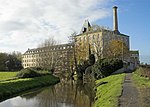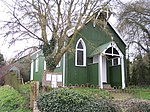Longney

Longney is a village on the River Severn 5 miles south-west of Gloucester, Gloucestershire, England, within the parish of Longney and Epney. The parish is long and narrow and the main trades are agricultural, with several farms throughout. Longney is the Saxon name meaning a long island. The population of the Longney and Epney parish is 285 (2011).Two roads run through the village. The first, Longney Road, leads to Elmore and Hardwicke, the other to Epney. Many houses were built in conjunction with the Gloucester and Sharpness Canal, brick construction provided by local brick works. Thatching for houses was from the reed beds at Frampton-on-Severn.The local school is a Church Of England Primary. The Grade I listed village church dedicated to St Laurence dates to the 13th century, and has a 14th-century tower. The ecclesiastical parish is part of the benefice of Hardwicke and Elmore with Longney, which is part of the Diocese of Gloucester.
Excerpt from the Wikipedia article Longney (License: CC BY-SA 3.0, Authors, Images).Longney
Chatter Street, Gloucester Longney and Epney
Geographical coordinates (GPS) Address Phone number Nearby Places Show on map
Geographical coordinates (GPS)
| Latitude | Longitude |
|---|---|
| N 51.8091 ° | E -2.3484 ° |
Address
Longney Church of England Primary Academy
Chatter Street
GL2 3SL Gloucester, Longney and Epney
England, United Kingdom
Open on Google Maps









